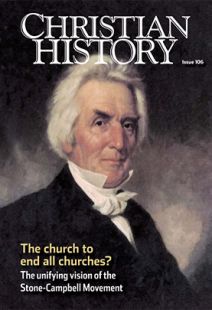“New woman” same gospel
“IN THE MORN of the resurrection, a woman was counted worthy to bear to the disciples the glad tidings of a risen Lord. But in the nineteenth century, she is counted by some brothers unworthy to tell the same tidings to the little children in the Sunday-school.” With these words, Silena Moore Holman (1850–1915) challenged prevailing teachings within the more conservative southern tradition of the Stone-Campbell Movement, eventually labeled the Churches of Christ.
Preaching it
Holman emerged at the end of the nineteenth century as the movement’s most articulate defender of a greater sphere of engagement for women. She and influential Church of Christ editor David Lipscomb engaged in a famous debate over the issue in the pages of Lipscomb’s journal, the Gospel Advocate, beginning in 1888.
Holman had come to her conclusions from her own life experience. The wife of a lay leader in her congregation, she mothered eight children, actively participated in her church in Fayetteville, Tennessee, and served for 15 years as the president of the Tennessee Woman’s Christian Temperance Union (WCTU).
During her tenure, she increased WCTU membership from 200 to more than 4,000. In all these actions, she represented the “new woman” of the late nineteenth century—a woman who enjoyed access to education and sought to participate in spheres once labeled “men only,” such as social reform movements and church leadership.
Her adversary, Lipscomb, along with southern churches who read his paper, opposed any public role for women in church or society. Lipscomb believed organizations such as the WCTU enticed women away from the joys of raising children and tending the home.
Telling glad tidings
According to Lipscomb, women who attended conventions, and especially those who spoke publicly, violated scriptural limits. He relied on passages such as 1 Timothy 2, which told women to keep silent in the churches and not to assume authority over men.
In her vision of women’s roles, though, Holman also upheld the Bible, crafting a well-reasoned scriptural defense of larger opportunities for women to lead and teach.
In particular, she criticized the use of Scripture to condemn all female involvement in the church and society: “The trouble with such people is that they base their ideas on some one passage of Scripture, when it is necessary . . . [to] take the Bible as a whole.”
She added that a “literal interpretation of the verse would keep women at home altogether, NOT ALLOWING THEM TO GO TO CHURCH AT ALL,” clearly not Paul’s intent. “Women were ‘last at the cross and first at the tomb,’” she argued, “and to a woman did our risen Lord first appear, while a woman received the first commission to tell the glad news of the resurrection.”
Holman eventually achieved recognition, not only among Churches of Christ, but also from the state of Tennessee. Two years after her death, through the influence of the WCTU, her portrait was placed in the State Capitol. At her death, she reportedly said, “I want no man to apologize for my work.” CH
By Loretta Hunnicutt
[Christian History originally published this article in Christian History Issue #106 in 2013]
Next articles
Worldwide disciples, worldwide Christians
How this most American of religious movements flourished on the world stage
Gary HollowaySeeking the body of Christ
Stone-Campbell believers still seek “a Bible faith, a holy life,” and a unified church
W. Dennis Helsabeck Jr.Support us
Christian History Institute (CHI) is a non-profit Pennsylvania corporation founded in 1982. Your donations support the continuation of this ministry
Donate



